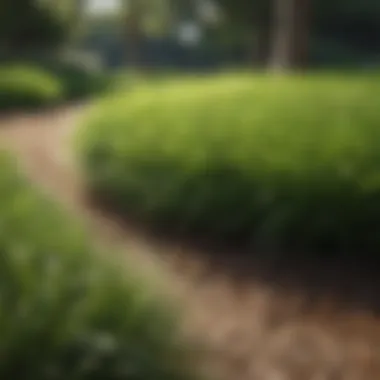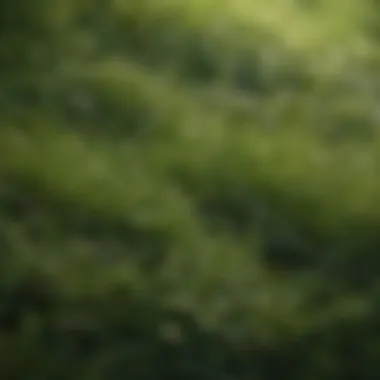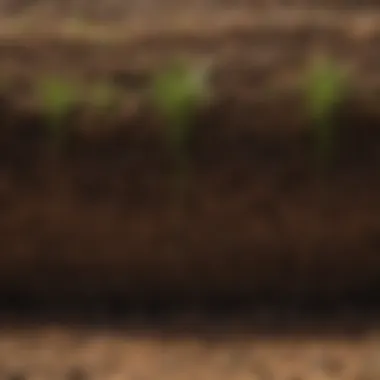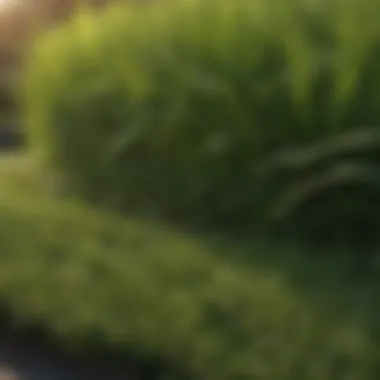Understanding Zoysia Grass Growth in Shady Areas


Intro
Zoysia grass, known for its dense growth and durability, has garnered significant interest among homeowners and horticulture professionals alike. Understanding its growth patterns, particularly in shaded environments, is essential for effective lawn management. Exploring the adaptability of Zoysia grass helps address common concerns regarding shade tolerance, soil health, and maintenance strategies. This guide aims to provide clear insights into whether Zoysia can thrive in less-than-ideal sunlight conditions.
Key Concepts and Terminology
Basic Definitions
To comprehend the capabilities of Zoysia grass, it is important to establish some foundational terms.
- Zoysia Grass: A warm-season turf grass that thrives in warm climates and is valued for its resistance to drought and pests.
- Shade Tolerance: The ability of plants to grow under limited light conditions, which can significantly affect the health and vitality of grass types.
Historical Context
Zoysia grass has been cultivated for various purposes since its introduction in the United States in the late 19th century. Initially planted for its ornamental value, its resilience in different environments led to its use in lawns and golf courses. Over the decades, various species of Zoysia have been developed to enhance shade tolerance, allowing it to adapt better in partially shaded regions.
Recent Innovations and Trends
Technological Advancements
Recent research into turfgrass management has identified specific hybrids of Zoysia that show improved adaptability to shade. For example, varieties such as Zoysia matrella are being studied for their growth performance under reduced light. Additionally, advancements in soil amendment technologies are aiding in maintaining soil health, which supports grass growth in less sun.
Sustainable Practices
Sustainable turf management practices have gained traction in recent years. Emphasizing organic fertilizers and reducing pesticide use are essential components of a modern landscaping approach. Utilizing native plants and incorporating Zoysia grass into diverse plant systems are also pivotal in promoting a healthier ecosystem.
Practical Applications and Techniques
Step-by-step Guides
To maximize Zoysia grass growth in shaded areas, consider the following strategies:
- Soil Testing: Analyze soil pH and nutrient levels to ensure optimal growing conditions.
- Select Appropriate Variety: Choose Zoysia types known for their shade tolerance, such as Zoysia japonica.
- Proper Watering: Ensure consistent moisture but avoid overwatering, which can lead to disease.
- Scheduled Mowing: Maintain a mowing height of 1.5 to 2 inches to promote denser growth and limit weed competition.
Case Studies
In various regions, homeowners have reported success with Zoysia grass in shaded yards by following tailored maintenance practices. For instance, a residential case in North Carolina highlighted improved growth patterns after applying a selective fertilizer designed for shade-tolerant grasses.
"Zoysia can thrive in less sunlight, but it requires attentive care to achieve the desired outcomes."
Understanding the nuances of Zoysia grass care in shaded conditions is critical. It not only informs landscaping decisions but also enhances the aesthetic quality of outdoor spaces. This guide serves as a foundation for anyone interested in harnessing the potential of Zoysia grass in challenging environments.
Understanding Zoysia Grass
Zoysia grass is a warm-season turf known for its adaptability and resilience. Understanding its characteristics is essential for any lawn care strategy, especially when dealing with shade conditions. Zoysia has a dense growth habit, which can lead to better competition against weeds compared to other grasses. This grass species not only offers a pleasing aesthetic but also demands careful consideration regarding its maintenance and growing conditions.
Zoysia grass thrives best in full sun but can perform reasonably well in partially shaded environments. This adaptability makes it a popular choice for many homeowners looking to maintain a healthy lawn under less-than-ideal light conditions. However, the performance of Zoysia in shaded areas can vary significantly based on species and environmental factors. Therefore, a deep understanding of Zoysia grass is crucial to optimizing its growth potential in different lighting scenarios.
Biological Characteristics of Zoysia
Zoysia grass features a unique biological composition that contributes to its growth patterns. Its growth habit is characterized by a deep root system, which allows for efficient water and nutrient uptake. Furthermore, it possesses a dense leaf structure that helps in retaining moisture and preventing soil erosion. The grass is also known for its warmth tolerance, requiring optimal temperatures in the range of 80 to 95 degrees Fahrenheit for vigorous growth. This biological resilience sets the foundation for evaluating its adaptability in shaded areas.
Common Species of Zoysia Grass


There are several species of Zoysia grass, each offering distinct benefits and limitations in terms of growth and shade tolerance.
Zoysia japonica
Zoysia japonica is one of the most widely used species. It is known for its robustness and ability to recover quickly from wear. The unique characteristic of Zoysia japonica is its creeping growth pattern, which allows it to spread across a lawn effectively. This species is typically considered a beneficial choice for homeowners looking for a lawn that withstands moderate foot traffic. However, it is less shade-tolerant than some other options, meaning it requires partial sunlight to flourish optimally.
Zoysia matrella
Zoysia matrella, commonly referred to as Manilagrass, exhibits finer leaf blades, leading to a dense and lush appearance. This species is especially valued for its ability to tolerate drought conditions and its adaptability to low fertility soils. Zoysia matrella is often chosen by those who prioritize aesthetics and durability. A notable feature is its improved shade tolerance compared to Zoysia japonica, making it a more suitable option for lawns that experience less sunlight.
Zoysia tenuifolia
Zoysia tenuifolia, or the Korean velvet grass, features narrow leaves and a dense growth habit. It is prized for its lush and carpet-like appearance, making it an attractive choice for ornamental lawns. This species generally has moderate shade tolerance and can survive in partial sunlight. Its unique characteristic of low mowing requirement adds appeal for maintenance-conscious homeowners. However, it might not be as drought resistant as other Zoysia types, marking a trade-off between aesthetics and resilience.
Origin and Cultural Spread
Zoysia grass is native to the warm regions of Asia, where it flourished in various climates. Over time, it has spread to different parts of the world, including North America, primarily due to its adaptability and appealing growth characteristics. Its introduction into the U.S. began in the early 20th century and it has since gained popularity among landscape professionals and home gardeners alike. Understanding the origin and cultural spread of Zoysia grass provides valuable context for its performance in diverse environmental conditions.
Shade Tolerance in Grasses
Shade tolerance is a critical aspect when considering the growth and maintenance of various types of grass. Zoysia grass, known for certain resilience, exhibits specific adaptations that allow it to thrive in conditions with reduced sunlight. Understanding shade tolerance helps landowners and horticulturists make informed decisions about grass selection and lawn care techniques. This section will take a closer look at shade conditions, mechanisms of adaptation, and how Zoysia compares with other grass types like fescue and Bermuda.
Defining Shade Conditions
Defining shade conditions is essential for understanding how Zoysia grass may or may not flourish in those environments. The two primary types of shade to consider are partial shade and full shade.
Partial shade
Partial shade typically refers to areas that receive about 3 to 6 hours of direct sunlight per day. It is significant in the context of Zoysia because it allows for sufficient light levels to encourage normal growth while still providing some respite from harsh sunlight. In these conditions, Zoysia can benefit from the cooler temperatures. This means that although it may not grow as vigorously as it would in full sun, it is considerably better positioned to thrive. The main advantage of partial shade lies in fostering a balanced environment where water retention can increase without stressing the grass too much.
Full shade
Full shade, on the other hand, pertains to areas receiving less than three hours of direct sunlight daily. Grass growth under full shade is often limited due to insufficient light for photosynthesis. Zoysia grass does show some adaptation to low light conditions, but its growth will generally be slower. In full shade, competition with other plants increases. While Zoysia can survive in these conditions, it does not grow as well compared to other areas. Homeowners should recognize that while Zoysia may endure relatively well in full shade, its overall health and vigor could be compromised.
Mechanisms of Shade Adaptation
Zoysia grass employs several mechanisms to adapt to shade. One prominent factor is the leaf structure. The leaves tend to be broader than in other grass varieties, which helps capture more light even under lower conditions. Moreover, Zoysia has a deep root system that facilitates water absorption, crucial in shaded areas where soil may remain moist for more extended periods. These physiological traits enhance its capability to access resources effectively, allowing the grass to survive despite light limitations.
Comparative Shade Tolerance
When evaluating Zoysia grass in shaded environments, it helps to compare its performance against other grass types such as fescue and Bermuda. Each type has distinct characteristics that influence its growth in these conditions.
Zoysia vs. Fescue
Fescue grass is renowned for its versatility in various shade conditions. It generally tolerates shaded areas better than other grass types. Its fine texture and denser growth allow for better leaf distribution, facilitating light capture. While Zoysia might not perform as well as fescue in these situations, it still holds advantages in warm climates, where fescue may struggle during hotter months. Therefore, fescue proves beneficial in shaded areas, but Zoysia can persist where the climate remains warm.
Zoysia vs. Bermuda
Bermuda grass thrives in full sunlight but struggles in shaded areas. In contrast, Zoysia shows much greater adaptability to varying light conditions. Bermuda has a rapid growth habit, but its inability to perform in shade can often make it a poor choice for lawns with trees. Zoysia, while slower to establish, can be advantageous due to its tolerance against more shaded conditions and reduced maintenance requirements overall.
Understanding these nuances allows for a more informed approach in lawn care, which is critical for optimal growth and health of Zoysia grass in shade.
Factors Influencing Zoysia Growth in Shade


Understanding the factors influencing Zoysia growth in shaded conditions is essential for optimizing its performance. Zoysia grass, while known for its adaptability, still requires certain environmental conditions to thrive. Key elements such as soil quality, moisture management, and regional climate play substantial roles in its growth. Acknowledging these factors helps both homeowners and horticulture professionals make informed decisions about cultivation practices. Improved management of these elements can potentially enhance the grass's viability in less-than-ideal sunlight scenarios.
Soil Quality and Composition
pH Levels
Soil pH is a critical aspect of Zoysia's growth. It dictates the availability of nutrients necessary for healthy grass development. Zoysia grass generally prefers a pH level between 6.0 and 7.0. At this range, essential nutrients are more accessible, which is beneficial for fostering robust growth. An imbalance in pH can lead to nutrient deficiencies, affecting overall health. Regular soil testing is a sound practice to maintain optimal pH levels. Notably, adjustments might be needed, depending on the surrounding vegetation or existing soil conditions.
Nutrient Availability
Nutrient availability directly influences Zoysia grass growth. Key nutrients include nitrogen, phosphorus, and potassium, all of which promote lush and vigorous growth. A sufficient supply of these nutrients in shaded areas can be challenging due to limited sunlight. Utilizing high-quality fertilizers that cater to Zoysia's specific needs is crucial for successful growth in shade. Understanding the unique nutrient needs of Zoysia allows for effective fertilization strategies that support its health even in lower light conditions. Regular soil amendments can enhance nutrient content, providing a solid foundation for growth.
Moisture Management
Watering Practices
Effective watering practices are vital for sustaining Zoysia grass, particularly in shaded environments. Shaded areas may retain moisture longer, so overwatering can lead to root rot and other problems. It's advisable to monitor soil moisture levels closely. A well-established schedule, typically deep and infrequent watering, promotes deep root systems, which is essential for Zoysia. Adjusting watering frequency based on rainfall and humidity levels ensures that the grass receives adequate hydration without saturation.
Drainage Considerations
Good drainage is essential for Zoysia's health, especially in shady spots where moisture can accumulate. Poor drainage presents a risk for diseases and can severely impede growth. Using soil amendments to improve drainage is important. Strategies may include aeration or mixing in sand to enhance the soil structure. Ensuring that water does not pool can significantly improve the growing conditions for Zoysia. Adequate drainage protects the grass from potential pitfalls associated with excess moisture.
Regional Climate Effects
Humidity Levels
Humidity substantially affects Zoysia grass growth. High humidity can promote vigorous growth, while excessively low humidity can stress the grass. Regions with naturally high humidity often see healthier and more resilient Zoysia. However, in arid climates, maintaining appropriate humidity levels is crucial. Homeowners may need to implement additional water sources, like sprinklers, to simulate higher humidity levels, especially during dry spells. Understanding the humidity patterns in a given area is beneficial for optimizing Zoysia's growth.
Temperature Variability
Temperature variability can have significant impacts on Zoysia grass cultivation. Zoysia thrives in warm-weather zones and generally does well under consistent temperatures. However, dramatic fluctuations can stress the plant and hinder its growth. When temperatures drop, Zoysia may enter dormancy, affecting its performance as a ground cover. Consequently, selecting the appropriate Zoysia species suited for the regional climate helps mitigate the risks associated with temperature changes. Knowledge of local climate conditions allows for better long-term planning for Zoysia cultivation.
By systematically addressing these factors, gardeners can significantly improve the likelihood of successful Zoysia grass growth in shaded areas.
In summary, grasping the nuances of soil quality, moisture management, and climate effects is vital for cultivating Zoysia in less-than-ideal sunlight. Each consideration works synergistically to create an environment where Zoysia grass can flourish, despite the challenges posed by shade.
Optimal Maintenance Practices
Maintaining Zoysia grass requires understanding specific needs, especially in shaded areas. Optimal maintenance practices play a critical role in supporting the health and vitality of Zoysia grass. These practices not only enhance growth but also increase its resistance to diseases and pests. Focusing on mowing techniques, fertilization strategies, and effective pest management can lead to a thriving lawn, even under less-than-ideal sunlight conditions.
Mowing Techniques for Shaded Areas
Mowing plays a significant part in how Zoysia grass develops when growing in shade. In shaded regions, it is crucial to adjust mowing height. Cutting the grass too short can stress it, leading to lethargic growth and increased susceptibility to diseases. Aim to cut Zoysia grass to a height of about two to three inches. This height allows the grass blades to capture the available light more effectively.
Frequent but light mowing can boost air circulation and reduce humidity around the grass blades. This practice is particularly important as shaded areas often create a moist environment, which can foster fungal diseases. Though Zoysia grows slower in shade, regular mowing helps maintain a neat appearance while contributing to its resilience. It's advisable to keep mower blades sharp to ensure a clean cut, minimizing damage to the grass.
Fertilization Strategies
Fertilization is another key aspect of maintenance, especially for Zoysia grass in shaded environments. Shaded grass typically has lower nutrient uptake due to reduced light. Hence, applying the right fertilizer in appropriate amounts is essential.
Using a slow-release nitrogen fertilizer can sustain growth over time. An application just before the growing season starts can be beneficial. Pay attention to the N-P-K ratio, which indicates the levels of nitrogen, phosphorus, and potassium. A balanced ratio will deliver the essential nutrients that Zoysia needs to thrive.
Additionally, soil testing can inform fertilizer choices. This testing reveals the current nutrient levels in the soil, helping to avoid over-applying fertilizers. This approach prevents excessive nutrient runoff, which can lead to environmental issues. Proper fertilization strategy aligns with enhancing Zoysia's growth patterns in shaded areas.


Pest and Disease Management
Effective management of pests and diseases is crucial in maintaining Zoysia grass. Healthy grasses are more vigorous and can resist pests better. However, shaded areas can sometimes harbor conditions that favor disease development and pest proliferation.
Common Pests
Several pests can affect Zoysia grass, including grubs and chinch bugs. Grubs feed on the roots, weakening the grass, while chinch bugs cause brown patches on the lawn. Their presence is concerning because once established, these pests can quickly spread and damage a larger area. Monitoring is essential. Regular inspections can help catch infestations early before they worsen.
Preventive Treatments
Preventive treatments are an effective method to manage pest threats and diseases before they escalate. Integrated Pest Management (IPM) strategies combine cultural, biological, and chemical controls. For instance, keeping the lawn well-aerated and ensuring proper drainage will minimize the chance of fungal diseases.
Additionally, applying natural insect repellents can support pest control without harming beneficial organisms. Chemical treatments may be necessary at times. However, they should be used judiciously to avoid causing harm to the environment or beneficial insects. Maintaining a healthy lawn environment is essential overall.
Common Issues with Zoysia in Shade
Zoysia grass is favored for its hardiness and aesthetic appeal. However, it is essential to assess how it performs in shaded locations. Understanding the common issues related to Zoysia's growth in such conditions allows homeowners and horticulture professionals to mitigate potential setbacks. Addressing these challenges ensures that Zoysia maintains its desired quality and health even when light exposure is limited.
Reduced Growth Rate
One notable issue with Zoysia grass in shaded areas is its reduced growth rate. While Zoysia has some degree of shade tolerance, it does not thrive in low-light conditions compared to more sunlit environments. The grass may take longer to establish, and its overall development could be stunted. Factors such as lack of direct sunlight can lead to slower photosynthesis, which is crucial for energy production in plants.
In areas where Zoysia is subjected to significant shade, its response often reveals insufficient vigor. This diminished growth can lead to uneven patches, and the lawn may appear thin or unhealthy over time. Homeowners need to monitor such patterns and consider alternatives if Zoysia struggles to flourish in shaded parts of their yards.
Increased Weed Competition
Another concern when growing Zoysia in shaded conditions is increased weed competition. Shady areas are inclined to foster various weeds, creating a struggle for resources between Zoysia and these unwanted plants. Weeds can capitalize on the lack of sunlight meant for Zoysia, potentially leading to overcrowded conditions.
When weeds such as clover or dandelions invade, they can outcompete Zoysia for water and nutrients, which will worsen its already reduced growth rates. It becomes vital for homeowners to engage in diligent maintenance. Regular weeding and applying mulch can minimize weed pressure and allow Zoysia to thrive.
Disease Development Risks
Lastly, Zoysia grass in shaded environments faces an increased risk of disease development. The combination of higher moisture levels and reduced airflow in shaded areas can create ideal conditions for diseases like brown patch or powdery mildew. These ailments can significantly impact grass quality and lead to patchy or dead areas in the lawn.
Monitoring for signs of disease is important for maintaining Zoysia health. Homeowners should adopt preventive measures, such as ensuring proper drainage and avoiding excessive watering. Addressing these issues promptly can lead to healthier grass and a better-looking lawn.
In summary, managing Zoysia grass in shady locations requires awareness of reduced growth rates, increased weed competition, and disease development risks. Proper management strategies can alleviate these issues and enhance overall grass health.
With careful attention to these common challenges, Zoysia can still serve as a viable option for lawns that do not receive full sun.
Epilogue
The topic of Zoysia grass and its growth in shaded areas is crucial for anyone interested in lawn care and sustainable landscaping. Understanding how Zoysia behaves in less-than-optimal lighting conditions can greatly influence a homeowner's or gardener's design choices. By grasping the nuances of this unique grass type, individuals can make informed decisions that enhance the beauty and health of their green spaces.
The benefits of cultivating Zoysia in shade include its resilience and adaptability. This grass species showcases a remarkable ability to withstand reduced sunlight compared to many other types. Homeowners can successfully establish Zoysia in areas with partial shade, thus maximizing the usability of their yards while keeping maintenance relatively low.
Additionally, the considerations outlined in this article highlight the importance of management practices. Soil quality, moisture levels, and regional climate play significant roles in determining whether Zoysia will thrive. Careful attention to fertilization, pest management, and mowing techniques can make a substantial difference in achieving a lush lawn, even in shaded regions.
In summary, by understanding Zoysia's growth strategy in shade, practitioners can achieve a beautiful lawn while navigating the challenges posed by reduced sunlight.
Summary of Key Points
- Zoysia grass exhibits a higher tolerance for shade than many other turf varieties.
- Critical factors affecting its growth in shaded conditions include soil quality, moisture management, and seasonal climate.
- Effective maintenance practices are essential for promoting healthy Zoysia in these environments.
- By understanding optimal care, homeowners can enjoy the benefits of Zoysia grass, even in less sunny regions.
Future Considerations for Zoysia Cultivation
Moving forward, there are several aspects to contemplate regarding the cultivation of Zoysia grass in shaded environments. Research continues to evolve, providing insights into new varieties that may offer improved shade resilience or faster establishment rates under lower light conditions.
As urban landscapes change, so do the conditions that Zoysia must adapt to. Factors such as changing climate patterns and urban development may impact soil composition and moisture availability. Therefore, ongoing studies regarding the adaptability of Zoysia to these shifting environmental factors will be crucial.
The focus should also be on creating best practices that include sustainable watering techniques and organic fertilization options to maintain soil health. The future of Zoysia cultivation in shade may rely on both traditional knowledge and innovative methods to ensure it thrives.















